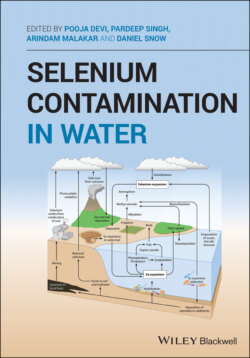Читать книгу Selenium Contamination in Water - Группа авторов - Страница 57
ii Chronic intoxication:
ОглавлениеChronic selenium poisoning is a consequence of the consumption of toxic levels of selenium (5–40 ppm) in plants such as grass or grain where selenium is bound in plant protein and is fairly insoluble in water. However, it has been shown that this condition can be caused by feeding the element's inorganic salts. The seleniferous feed must be eaten for weeks or months to have its effect. The key symptoms of poisoning in cattle and horses include hair loss, emaciation, hoof malformations, and lameness. Perhaps the worst economic impact arising from seleniferous forage intake is lower reproduction.
Blind stagger type chronic selenium poisoning is said to be induced by organic selenium compounds. To show evidence of poisoning the animals will need to ingest highly toxic amounts of these plants over a significant period of time. The condition of blind staggers is described in three stages. The animal has some vision loss in the first stage, and wanders in circles, disregarding objects along its way. In the second stage, the signs in stage one reach extreme severity and the forelegs of the animal are weak and give way. In the third stage, oral activity is arrested. The mechanism of the tongue and swallowing becomes paralyzed, respiration is staggered and quickened, abdominal pain is evident, and the cornea becomes cloudy. The third stage occurs unexpectedly and death frequently follows within a couple of hours, usually due to respiratory arrest.
Toxicopathology relies on the concentration of selenium in blood and organs ranging from 1 to 5 ppm across the entire livestock in the seleniferous zone (O'Toole and Raisbeck 1995). The sub‐chronic and chronic toxicity of the Se causes pathological changes in the skeletal muscle, heart, liver, spleen, and kidney, as they are mostly accumulated at a higher level in these organs (Rosenfeld and Beath 2013). There are reports of histopathological changes such as disrupted endocardium layer, diffuse lung hemorrhages, parenchymal layer degeneration with focal necrosis in hepatic tissues, and nephritis (Faye and Seboussi 2008). Table 4.2 provides the recommended normal intake of selenium in animals per day.
